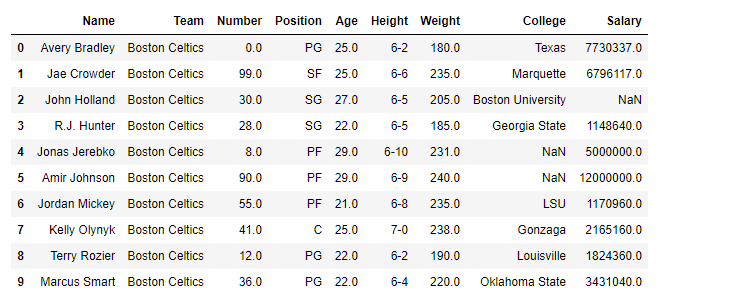Python | Pandas dataframe.all()
Last Updated :
16 Nov, 2018
Python is a great language for doing data analysis, primarily because of the fantastic ecosystem of data-centric python packages. Pandas is one of those packages and makes importing and analyzing data much easier.
DataFrame.all() method checks whether all elements are True, potentially over an axis. It returns True if all elements within a series or along a Dataframe axis are non-zero, not-empty or not-False.
Syntax: DataFrame.all(axis=0, bool_only=None, skipna=True, level=None, **kwargs)
Parameters:
axis : {0 or ‘index’, 1 or ‘columns’, None}, default 0
Indicate which axis or axes should be reduced.
0 / ‘index’ : reduce the index, return a Series whose index is the original column labels.
1 / ‘columns’ : reduce the columns, return a Series whose index is the original index.
None : reduce all axes, return a scalar.
skipna : Exclude NA/null values. If an entire row/column is NA, the result will be NA.
level : If the axis is a MultiIndex (hierarchical), count along a particular level, collapsing into a Series.
bool_only : Include only boolean columns. If None, will attempt to use everything, then use only boolean data. Not implemented for Series.
**kwargs : Additional keywords have no effect but might be accepted for compatibility with NumPy.
Returns: all : Series or DataFrame (if level specified)
Note: Nan value will be treated as non-empty value and hence it will be evaluated as True.
For link to CSV file Used in Code, click here
Example #1: Suffix _col in each columns in the dataframe.
import pandas as pd
df = pd.read_csv("nba.csv")
df[:10]
|

Output:

Example #2: Evaluate for column-wise behaviour
dataframe.all() Default behaviour checks if column-wise values all return True.
Output:

Example #3: Check for row-wise elements
Specify axis=’columns’ to check if row-wise values all return True. if all values in any specific row evaluate to true then the overall row will be evaluated as true.
import pandas as pd
df = pd.read_csv("nba.csv")
df.all(axis ='columns')
|
Output:

all() evaluates all value across all of the rows in the dataframe and outputs a boolean value for each row.
Example #4: Check for all values in the dataframe
Specify, axis=None for whether every value is True in the dataframe.
import pandas as pd
df = pd.read_csv("nba.csv")
df.all(axis = None)
|
Output:

Like Article
Suggest improvement
Share your thoughts in the comments
Please Login to comment...